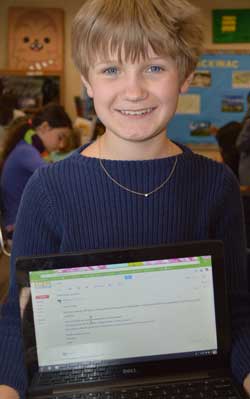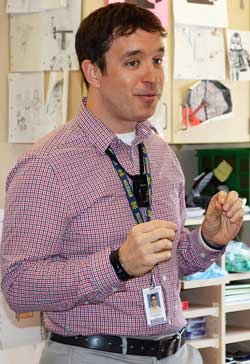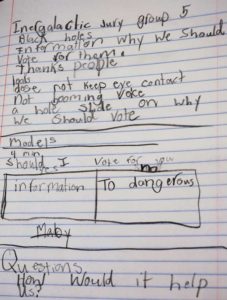Black holes, life on Mars, interstellar travel, asteroid shields and alien communication … on which effort should NASA focus next, and why? At Wealthy Elementary, it was up to the intergalactic jury to decide.
Calder Stanley held that we should send a Rover to search for life on Europa, a moon that orbits Jupiter, because “there may be corals and fish and other stuff on that planet.”
Nava Tabata argued that when studying black holes, “it would be safer to send a probe than a human, because it would be better to lose a probe than it would be to lose a human.”

Mikki Robinson maintained that you could keep food from going bad on another planet by having “air tanks that are kind of like refrigerators, but with air.”
Fourth-graders in the Wealthy Elementary classes of Tim Saunders, Winona Tinholt and Elizabeth Anderson spent four weeks working in small groups to research and propose NASA’s next big Apollo-like project.

Not on Common Core
Though it might appear the project satisfied science curriculum, teacher Tim Saunders said it actually focused on Common Core standards for English language arts.
The project, now in its sixth year, begins when the teachers ask students what they wonder about space, Saunders said. The answers are whittled to 20 topic choices, then students form groups with others who are interested in the same topic.
“A lot of it is compromise and learning to work with one another, and none of that is in the Common Core,” Saunders said. “It’s life skills, and students are in different points in that journey, so this is great practice.”

Part of the research involves learning to craft and actually sending specific questions related to their projects to noted experts. And when they say experts, they’re talking experts: Emily Grin wrote to Bill Nye the science guy. She didn’t get an answer, but hey, there’s bragging rights even in having hit “send.”
Plenty of students have had responses, most notably from Konstantin Batygin, a Russian-American astronomer and assistant professor of planetary sciences at California Institute of Technology. He’s one of the guys behind the discovery of a ninth planet, Saunders explained.
And for the expert connections, Wealthy students have Emily’s big sister Caroline to thank. Caroline was in Saunders’ class the first time he did the project, and suggested they write to living experts when Saunders proposed writing to historical figures.

Ideas on Trial
The culminating activity was essentially a mock trial, where students tried to convince their classmates to vote for their project idea. They were graded not only on content but on eye contact, reasoning and whether their thesis statements were clear and accurate.
Saunders said he created intergalactic jury with previous Wealthy Principal Anthony Morey, based on a mock trial Morey had his middle school students complete when he taught social studies.
This year’s winner was the black-holes group, but Saunders watched the online votes tally in real time and said they were within single digits of one another.
“I’m not surprised; it was really hard to decide,” he said. “They were all impressive.”









